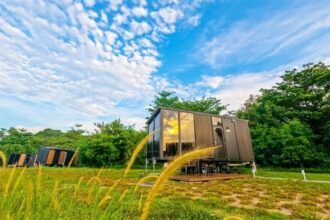Deodhar Cottage
We all are somewhere looking for peace ultimately. ‘The life of inner peace, being harmonious and without stress, is the easiest type of existence.’ – Norman Vincent Peale. One of the most positive little towns I came across was Kotgarh, where peace was just part of the atmosphere.
About Kotgarh
Kotgarh is a beautiful valley at an elevation of 7,000 feet overlooking the Satluj River and snowcovered sub-Himalayan Range. This village is 80 kilometers from Shimla on the old Hindustan Tibet Road. The Road bifurcates from National
Highway 22 at Narkanda toward Kotgarh.Kotgarh is laden with history as it was the capital of
Kotkhai-Kotgarh’s princely state, which was later shifted to Kiariin Kotkhai.
Read:https://nomadlawyer.org/stone-wood-homestay-solitude-in-shimla/
A Peek Into History Of Kotgarh
In 1815, Kotgarh became a British territory after the Gurkhas were defeated by the British. The British were impressed by the location, and beauty of the valley. They encouraged missionary
work in the area. You can find the impact of British rule here.
The old heritage homes still reflect the English flavor. Kotgarh was incorporated into British India in 1815 and later to India in 1947.
The Story Of Satyananda Stokes or Samuel Evans Stokes, Jr
This little town is full of interesting stories, like the one about Satyananda Stokes. Satyananda Stokes was actually Samuel Evans Stokes, Jr. (16 August 1882 – 14 May 1946).
Samuel Stokes belonged to a well-reputed Christian family in Philadelphia, USA. His personal passion was to work in the social work area so he moved away from his family business. In1916, he visited India and started working with lepers near Shimla. He also worked as a missionary to spread the teachings of Christianity. He decided to move to a more peaceful town in
Kotgarh. He was so allured by the people and beauty of the area that he decided to settle here permanently. He married a local girl, by the name of Agnes Benjamin who was from Sirkeck
family. He faced a lot of negativity from the locals regarding him being a Christian so he converted into a Hindu and renamed himself, Satyananda Stoke, his conversion was done by Lambidhar, known as Babu Shama Nand. Satyanand participated in the freedom struggle of India too. The descendants of Satyanand Stokes still live in Kotgarh.
Kotgarh: The Apple Bowl Of India
Satyananda’s family used to grow apples in Louisiana, USA. His family was into the apple orchards business and Satyananda was familiar with techniques. He felt the climate in Kotgarh was similar so imported the first sapling of the apple plant from his family-owned Stark Apple Nursery in Louisiana and planted it in Kotgarh. And this was how India got its first Apple orchard, in 1916.
Today Kotgarh is known as the apple bowl of India and the area is one of the wealthiest in Himachal Pradesh due to its high quality apple and cherry cultivation.
As he was a great social worker, he encouraged the local farmers to grow apples in their fields. It’s been 100 years since he propagated the first apple trees here, and the locals still enjoy the revenue through this profession.
There are many fascinating places to visit in Kotgarh. Built-in 1872, the St. Mary’s Church stands out as an example of Gothic architecture. The Church is located in the middle of the Kotgarh.
Then we have the Tani Jubbar lake which is 9 km away. A temple dedicated to Nag Devta is in the vicinity of the lake. Also, a bird watcher’s delight.
The people of Kotgarh are rich in their culture and heritage and protective too. If you want to actually find real India and enjoy true folk attire, Architecture, music, dance, and local food, come to Kotgarh. The people enjoy every aspect of their existence to the core through festivals and folklore.
The locals are still holding onto their traditional attire. The traditional dress of women comprises the rezta (long dress), the dhatu (head scarf), and the saluka (waistcoat).
During the winter months (November to March) the women wear a woolen garment called “Phakti”. The men wear a Kurta, a pyjama called Sutan and a Saluka.
Music and dance are always part of their daily chores. There is a local traditional Pahari Baja (set of musical instruments), that is seen on all festive occasions like marriages and fairs which are known as Jatar. The local Baja is used for accompanying the Devtas (local Gods) for Jatars (local fairs).
The Baja comprises of –
. Two large Dhols
. Nagaras or Half drums
. Bhana or a Metal plate
. Two pairs of Karnals or low-frequency horns
. Narsingha or S-shaped high-frequency horns
. Sarnai (Shenai) plays melodies notes
. Gujju – an instrument that makes vibrating sounds
. Kawari- a long instrument that makes low-frequency sound
The local dance called Nati, is a four-beat dance rhythm, unevenly matched. There is another form of dance performed indoors called “Bhitru Nach”, in which songs relating to mythology are sung. The instruments used in Bhatru Nach are Dholki, Khangri, and Tahli.
Fairs and Festivals are an intrinsic part of local culture and an important medium to hold onto their core value systems. Fairs are held to welcome different seasons or during harvesting season etc. The local deities are invited to these fairs, alongwith the local Baja. There is lots of enthusiasm and excitement and all join the Nati performance to add to the local traditional flavor.
The main fairs or Jatars are celebrated throughout the year, mainly- Mela Faag (March)- Devtas are invited by the king of Bushar on the day of Holi Dhada Thirshu, (April)- This is the first Fair of the year which marks the setting of the Apple crop, Krangla ka Bishu- April, Bhutti Jagra- May Shraugh Jatar -16 June, Dudh Bali -26 June, Tani Jubbar- 30 June, Lavi mela – 11 November, Tharu ka Thirshu- last mela (Toward the end of the year).
Fairs, food, and traditions go hand in hand. The local dishes are prepared in an authentic way to maintain the recipe’s legacy. For those who plan to travel during these festivals, you must try these dishes.
Pakaian – Wheat flour stuffed fried bread, Siddu – Steamed Leavened bread with a stuffing of dry fruits etc, Baturu – Bread made out of fermented flour on a griddle, Indra – Made out of kulthi dal and Deshard Allo, (Arbi) Dhindra – A combination of Besan flour and Arbi leaves, Baahdi – A combination of wheat, sugar or salt, ghee, and water Khatta – Curd and Whey cooked with spices, Laphi – Made with a grind of corn like porridge, Lauta – Pancake of wheat flour, Delle ki chutney- Chutney made of apricot kernel, Brunj – Sweetened fried rice in ghee, Sera – Sweet dish cooked in ghee from the extract of wheat grain, Red rice – Special rice grown in Himalayan glaciated-water-fed farms, Kodha roti – Indian flat bread made from Kodha, Makki roti –Corn flour Indian flat bread served with fresh white butter.
Read:https://nomadlawyer.org/best-place-to-stay-in-spiti-hotel-spiti-heritage/
Deodar Cottage: A Perfect Homestay In Kotgarh
I was really looking forward to experiencing all these aspects of Kotgarh, and this was made possible because of the warm hospitality of Atul Mehta and his family.
Atul runs a homestay called Deodar cottage, 17 kilometers from Narkanda in the heart of the Kotgarh Valley.
His extremely well-decorated place called Deodar cottage is situated in the heart of apple and cherry orchards in Thanedhar village. It is a 2.30-hour drive from Shimla.
Atul Mehta took one of the toughest decisions to leave his professional life in Delhi and move back to his family home in Kotgarh. His mother was a strong supporter of progressive thinking and she actually encouraged him to use part of the large house as a bed and breakfast place for travelers.
Deodar cottage has one of the most heavenly views I have seen. One can sit for hours watching the changing vistas, with a cup of coffee, or with a book from their well-stocked library. The true attraction, apart from the location, is the home-cooked meals, supervised by his mother, along with all the homemade pickles which decorate their dining table.
A Pet lover like me was in for a treat, having his two lovely dogs making me feel completely at home while his cats snuggled close, giving me all the warmth possible.
One never gets bored as Atul himself will take you for a village walk along the apple-clad roads. The best way to experience a Himalayan village is to experience it with a local expert. Atul will charm you with all the knowledge, the history, the folk stories,and especially his love for his roots which are deeply ingrained. So, a stay at Deodar cottages is a memorable experience in itself. Kotgarh makes you actually fall in love with nature and its people. A place you will want to visit, again and again, and again.
Contact: Atul Mehta – 94180 63519/ 01782-222112
Email- info@deodarcottage.com
Travel And Don’t Stop!





